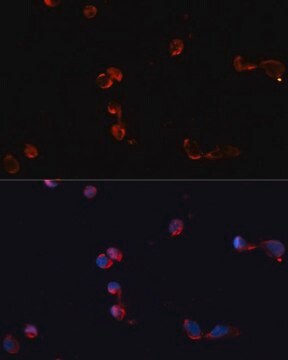C9336
Anti-Chloramphenicol Acetyl Transferase (CAT) antibody produced in rabbit

IgG fraction of antiserum, buffered aqueous solution
Sinonimo/i:
CAT Antibody - Anti-Chloramphenicol Acetyl Transferase (CAT) antibody produced in rabbit, Cat Antibody
About This Item
Prodotti consigliati
Origine biologica
rabbit
Coniugato
unconjugated
Forma dell’anticorpo
IgG fraction of antiserum
Tipo di anticorpo
primary antibodies
Clone
polyclonal
Forma fisica
buffered aqueous solution
PM
antigen 26 kDa
Convalida avanzata
recombinant expression
Learn more about Antibody Enhanced Validation
tecniche
indirect immunofluorescence: 10 μg/mL using eukaryotic cells transfected with a plasmid bearing the CAT gene
western blot: 10 μg/mL using eukaryotic cells transfected with a plasmid bearing the CAT gene
Condizioni di spedizione
dry ice
Temperatura di conservazione
−20°C
modifica post-traduzionali bersaglio
unmodified
Descrizione generale
Specificità
Immunogeno
Applicazioni
- immunoblotting
- indirect immunofluorescence
- immunofluorescence microscopy
Azioni biochim/fisiol
Anti-Chloramphenicol Acetyl Transferase (CAT) antibody is specific for bacterial CAT and recombinant CAT expressed in transfected eukaryotic cells (a predominant band of approx. 26 kD). Staining of CAT by the antibody is inhibited by the bacterial CAT antigen in cells transfected with CAT.
Stato fisico
Esclusione di responsabilità
Non trovi il prodotto giusto?
Prova il nostro Motore di ricerca dei prodotti.
Codice della classe di stoccaggio
10 - Combustible liquids
Classe di pericolosità dell'acqua (WGK)
WGK 3
Punto d’infiammabilità (°F)
Not applicable
Punto d’infiammabilità (°C)
Not applicable
Certificati d'analisi (COA)
Cerca il Certificati d'analisi (COA) digitando il numero di lotto/batch corrispondente. I numeri di lotto o di batch sono stampati sull'etichetta dei prodotti dopo la parola ‘Lotto’ o ‘Batch’.
Possiedi già questo prodotto?
I documenti relativi ai prodotti acquistati recentemente sono disponibili nell’Archivio dei documenti.
Il team dei nostri ricercatori vanta grande esperienza in tutte le aree della ricerca quali Life Science, scienza dei materiali, sintesi chimica, cromatografia, discipline analitiche, ecc..
Contatta l'Assistenza Tecnica.




